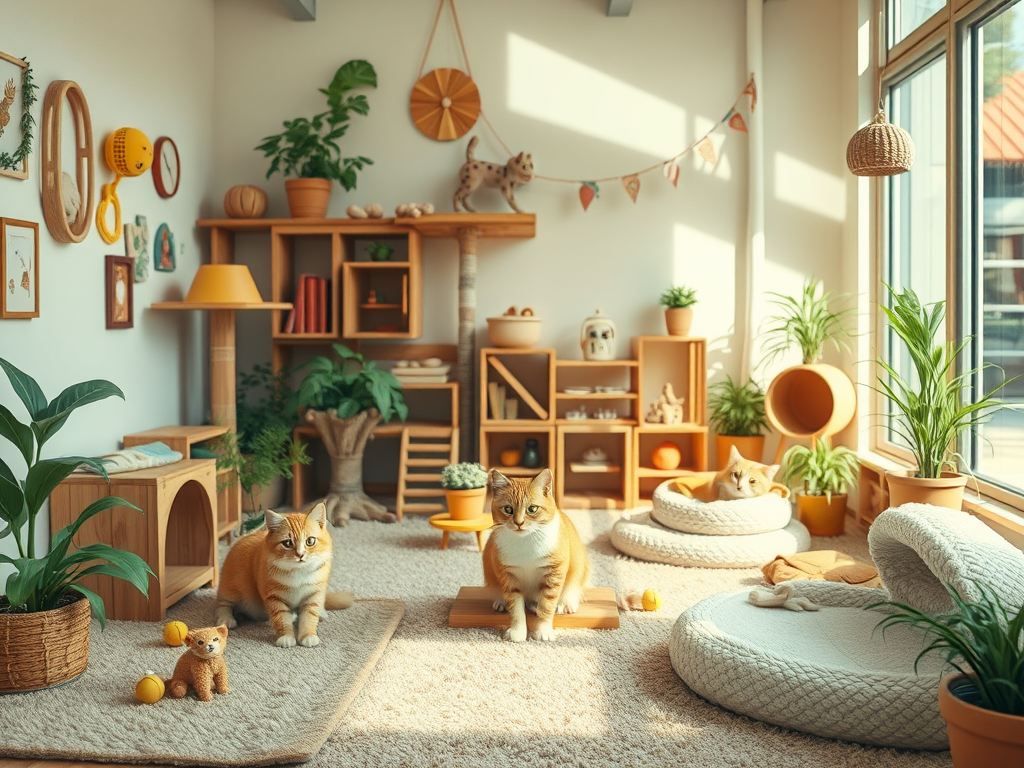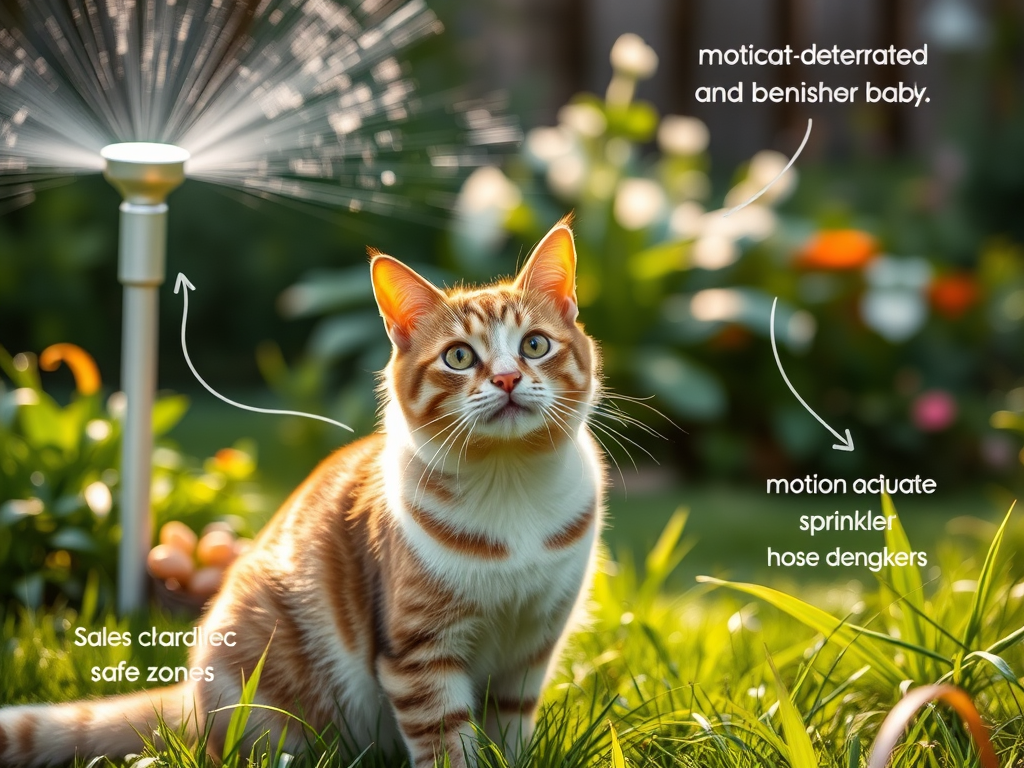Effective Strategies for Reducing Your Cat’s Natural Hunting Behavior
Reducing the Impact of Your Cat’s Hunting Instincts: Cats have a natural instinct to hunt, a behavior deeply ingrained in their genetic makeup. To protect local wildlife while still nurturing this instinct, it’s essential to create a safe indoor environment that satisfies their hunting urges. By designing engaging spaces filled with stimulating activities, you can ensure your feline companion remains active and fulfilled without threatening the well-being of outdoor animals. This approach not only enriches their life but also fosters a deeper connection between you and your pet.
Incorporating interactive toys into your cat’s playtime can significantly enhance their indoor hunting experience. Choose from feather wands, laser pointers, and motorized mice that captivate your pet for longer periods. These toys simulate natural hunting actions, allowing your cat to track, leap, and pounce, which is crucial for their mental and physical health. By engaging them in play with these stimulating toys, you not only keep them entertained but also promote their overall well-being by directing their energy into constructive activities.
Transform your living space into a captivating feline playground by constructing obstacle courses filled with dynamic elements like boxes, tunnels, and elevated shelves. This personalized jungle gym encourages exploration and vigorous activity, allowing your cat to climb, jump, and investigate different environments. Given their natural curiosity, providing varied spaces for exploration can mimic their instincts in the wild, making them feel as though they are embarking on an exciting adventure in their very own safari.
Never underestimate the value of puzzle feeders. These unique devices not only challenge your cat mentally but also mimic the effort they would exert while hunting. By incorporating treat-dispensing puzzles into their daily routine, you can keep their minds sharp while delivering a fun and rewarding experience. This method not only entertains your pet but also fosters healthier eating habits, encouraging them to work for their treats and thereby reducing the urge to hunt.
Prioritize playtime in your daily routine. Engaging in social interaction through play is vital for strengthening the bond between you and your cat. Make it a point to schedule dedicated play sessions, using the same toys that they enjoy during solo play times. This shared engagement alleviates any frustration your cat may experience and enhances your relationship, making playtime a rewarding experience for both you and your feline friend.
Creating an engaging indoor environment for your cat is entirely achievable with some creativity and commitment. Your home can evolve beyond just a shelter, transforming into an adventurous landscape that fulfills their natural hunting instincts while keeping them safe from outside dangers. With thoughtful planning and effort, you can nurture a happy and fulfilled indoor cat.

Unlocking New Adventures Through Leash Training for Your Cat
Introducing leash training can offer your cat a world of exploration while ensuring their safety. While many associate walks primarily with dogs, cats can also partake in outdoor adventures when trained correctly with time and patience. By familiarizing your feline with a harness and leash, you can give them the chance to enjoy nature while remaining securely under your supervision.
Begin your leash training journey with a properly fitted harness that is comfortable for your cat. It’s crucial to allow your pet to get accustomed to the harness before attempting to put it on. Let them explore the harness by sniffing and inspecting it, which will help alleviate any anxiety they might feel. Gradually introducing the harness at their pace will create positive associations and make the process smoother for both of you.
Once your cat feels comfortable wearing the harness, attach a lightweight leash and start practicing indoors. This familiar environment will aid them in adjusting to the sensation of wearing a leash and help build their confidence. Take your time and expect some initial resistance; patience is essential as you help your cat acclimate to this new and exciting experience.
When it’s time for outdoor excursions, select a calm and secure area, such as your backyard or a quiet park. Ensure that the location has minimal traffic and distractions to create a safe atmosphere for your cat. Start with short outdoor sessions to avoid overwhelming your pet, gradually increasing the duration as they become more comfortable and confident in exploring their new surroundings.
Supervised outdoor time enriches their lives, allowing them to enjoy the sights, sounds, and scents of nature while ensuring the safety of local wildlife. Picture the joy on your cat’s face as they discover new experiences in a secure setting. This bonding time not only enhances their quality of life but also strengthens your relationship, creating cherished memories together.
Real-life experiences from fellow cat owners can serve as inspiration. Many have initially wondered whether their cats would take to leash walking, but with consistency and positive reinforcement, they found great success. Celebrate each small achievement as it expands your cat’s horizons while maintaining their safety and well-being.
Incorporating leash training into your cat’s routine allows for a harmonious mix of outdoor enjoyment and wildlife protection. This balanced approach enables your cat to explore while fostering a sense of security in their environment.
Creating Safe Outdoor Environments: The Advantages of Catios
Outdoor cat enclosures, commonly known as catios, offer an excellent solution for adventurous cats yearning for outdoor experiences without the associated dangers. These secure spaces allow your feline friends to enjoy the outdoors safely while helping to protect local wildlife from potential threats.
Building or purchasing a catio can be customized to fit your available space, budget, and your cat’s needs. Options range from simple balcony enclosures to more elaborate backyard structures. The primary focus should be on ensuring the catio is escape-proof since safety is the top priority in providing a secure environment for your cat.
When designing your catio, consider incorporating multiple levels and cozy hiding spots. Cats thrive in environments that provide vertical spaces and areas to retreat. By integrating platforms, ramps, and hammocks, you can transform a basic enclosure into a stimulating paradise that closely resembles their natural habitat.
Enhancing the sensory experience within the catio is also beneficial. Consider adding elements like cat grass, scratching posts, or logs to create an engaging environment filled with diverse textures and scents. This sensory enrichment can keep your cat entertained and content while allowing them to relish the joy of being outdoors in a controlled setting.
Regular maintenance is crucial to ensuring the continued safety of your catio. Routinely check for signs of wear and tear, including the integrity of the mesh, the structure itself, and the locking mechanisms. Cats are naturally curious and may test the boundaries of their enclosure, so it’s vital to keep it in excellent condition for their safety and well-being.
With a catio, your feline companion can enjoy sunbathing, climbing, and observing wildlife without posing a threat to local ecosystems. They can bask in the sun and watch birds from the security of their outdoor haven, ensuring their happiness while wildlife remains undisturbed.

Proven Behavioral Training Techniques to Reduce Hunting Instincts
Teaching your cat to minimize their hunting behaviors may appear challenging at first, but with the right methods, it can be an achievable task. The initial step involves understanding their natural instincts and behaviors that drive their hunting tendencies, which is crucial for implementing effective training strategies.
Utilizing technology can significantly enhance your training efforts. Consider employing motion-activated deterrents, such as sprinklers or noise-makers, to create boundaries that discourage hunting without disrupting your cat’s other activities. Strategically zoning your yard into safe areas can help redirect your cat’s focus away from potential prey.
Positive reinforcement plays a vital role in modifying your cat’s behavior. Reward them for not engaging in hunting behaviors with treats or affection. For instance, if your cat responds to your call or refrains from pursuing a possible target, offer them a tasty treat or extra cuddles. This approach encourages them to repeat desired behaviors while reducing their instinctual urge to hunt.
Incorporating clicker training can also be an effective method. This technique involves associating a distinct sound with positive actions, enabling your cat to connect their behavior with rewards. By clicking when they demonstrate the desired behavior, you can reinforce good habits and clarify your expectations.
For personalized guidance, consider consulting with feline behavior specialists. They can offer tailored advice and insights that address specific challenges, facilitating a harmonious coexistence between you and your cat while respecting local wildlife.
The objective of using deterrents and training is not to punish but to guide your cat toward behaviors that prioritize their safety and the environment. With consistency and patience, you can successfully redirect their instincts, leading to safer outdoor interactions for both your cat and local wildlife.
Nutritional Strategies to Alleviate Your Cat’s Hunting Drives
The type of food you provide and the feeding methods you adopt can greatly impact your cat’s hunting instincts. Interestingly, a well-fed cat may still display hunting behaviors; however, the way you feed them can effectively help mitigate this drive.
Free feeding, where food is available throughout the day, may not be the best approach for every cat. Instead, consider implementing scheduled feeding times. By establishing consistent mealtimes, your cat may be less likely to hunt, as they learn to associate food with specific times of the day, thereby decreasing the urge to seek out prey.
Interactive feeding strategies can also be transformative for your cat’s behavior. Utilizing food puzzles or dispensers can replicate the act of hunting, requiring your cat to ‘work’ for their meals. This not only keeps them mentally and physically engaged but also channels their energy positively, allowing their natural instincts to be expressed safely.
Additionally, pay attention to the nutritional content of their food. A diet that is high in protein and low in carbohydrates aligns better with a cat’s natural dietary needs, potentially leading to a decrease in hunting behaviors. Collaborating with a veterinarian can help tailor their diet to ensure that your cat’s nutritional needs are effectively met.
Finally, offering a variety of food types can satisfy their inherent curiosity and craving for novelty. Switching between dry kibble, wet food, and raw diets can keep mealtime interesting, reducing the temptation to seek thrills beyond their food dish.
Feeding strategies go beyond mere sustenance; they serve as a powerful tool for managing your cat’s behavior. By adjusting how and what you feed them, you can effectively diminish their inclination to hunt while keeping them satisfied and healthy.

Fostering Community Responsibility for Cat Conservation
Cats are cherished companions, and as their caretakers, we bear the responsibility to ensure they exist harmoniously with local wildlife. By committing to community efforts and personal responsibility, we can significantly reduce the ecological impact of free-roaming cats.
Engaging with local conservation groups is an excellent way to stay informed about wildlife-friendly practices. Many communities offer educational workshops for cat owners, addressing the ecological consequences of allowing cats to roam freely while providing solutions to mitigate these effects.
Consider initiating or participating in neighborhood discussions or social media groups centered around responsible pet ownership. Sharing resources, tips, and experiences can promote a more wildlife-conscious community, creating a supportive environment for all pet owners.
One proactive approach is to establish cat-friendly zones within communal gardens or parks. These designated areas can include enclosures or supervised play spaces, ensuring a safe environment for both cats and wildlife. This collaborative effort enhances awareness and promotes positive interactions between pets and nature.
Incorporating family-friendly initiatives, such as sticker campaigns or educational contests for children and teens, can raise awareness about responsible pet ownership and the importance of coexisting with nature.
Lead by example at home by applying the strategies you’ve learned. Whether it’s leash training, building catios, or modifying feeding practices, showing your commitment to a harmonious relationship between your cat and the environment can inspire others to follow your lead.
By combining individual actions with community initiatives, we can cultivate a supportive network that balances our cats’ needs with ecological stewardship. Together, we can cherish our pets while respecting and protecting the natural habitats around us.
The Article: Minimize Your Cat’s Hunting Impact Appeared First On Unity Pets.
The Article Minimize Hunting Impact of Your Cat Effectively Was Found On https://limitsofstrategy.com


I really appreciate your emphasis on creating a stimulating indoor environment for our cats! I’ve noticed that incorporating puzzle feeders not only keeps my cat mentally engaged but also satisfies that hunting drive. It’s fascinating how these small changes can make a big difference in their overall happiness and health. Plus, I’ve found that playing together with these interactive toys can strengthen our bond—it’s like we’re on a mini-hunting expedition in our living room! Have you come across any other innovative ideas or tools that effectively engage cats while keeping them indoors?